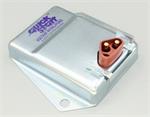MadScientistMat
Well-Known Member
- Joined
- Mar 6, 2008
- Messages
- 605
- Reaction score
- 207
We've had a few discussions of the current state of replacement voltage regulators for our Mopars, such as this thread. To get a closer look at what's going on in your general parts-store replacement Chrysler alternator voltage regulator, I have bought one (a MasterPro 2VR1, about $32 at O'Reilly), and will take it apart and put it under a microscope to show you how it works and where these may have room for improvement.
From the outside, it looks like your standard voltage regulator. We have a stamped sheet metal casing and a molded plastic connector with a folded metal bracket.

The back is sealed with potting compound. There are several types of material that can be called potting compound; they are usually epoxies or urethane.

As this material cuts easily with a knife, I'm going to say it is most likely urethane. I switched to a box cutter after this picture was taken. I could have used something more aggressive, but didn't know if there was anything inside the potting compound that might be damaged.

Enough cutting revealed a layer of sand under the potting compound.

Once I had cut around the perimeter of the potting compound, I was able to pry it out to see what was under it.

The potting compound peeled off in one piece.

Here's what's underneath. The wire on the right was caught in the potting compound and broke off the circuit board. Let's have a look under that sand..

Here we have a surface mount, single sided PCB. Probably FR2 or a similar laminated paper substrate. There are a total of 12 components populating the board, nothing more complex than a transistor.

When I said I would put this under a microscope, I meant it. Stay tuned for an analysis of the circuit board.
From the outside, it looks like your standard voltage regulator. We have a stamped sheet metal casing and a molded plastic connector with a folded metal bracket.
The back is sealed with potting compound. There are several types of material that can be called potting compound; they are usually epoxies or urethane.
As this material cuts easily with a knife, I'm going to say it is most likely urethane. I switched to a box cutter after this picture was taken. I could have used something more aggressive, but didn't know if there was anything inside the potting compound that might be damaged.
Enough cutting revealed a layer of sand under the potting compound.
Once I had cut around the perimeter of the potting compound, I was able to pry it out to see what was under it.
The potting compound peeled off in one piece.
Here's what's underneath. The wire on the right was caught in the potting compound and broke off the circuit board. Let's have a look under that sand..
Here we have a surface mount, single sided PCB. Probably FR2 or a similar laminated paper substrate. There are a total of 12 components populating the board, nothing more complex than a transistor.
When I said I would put this under a microscope, I meant it. Stay tuned for an analysis of the circuit board.


















